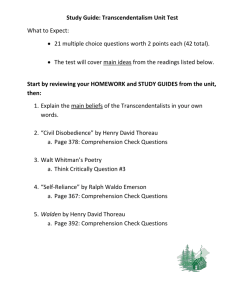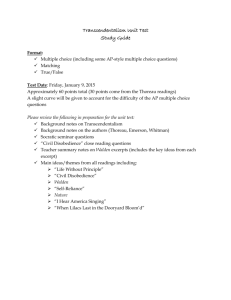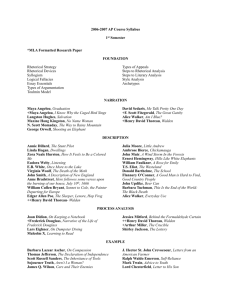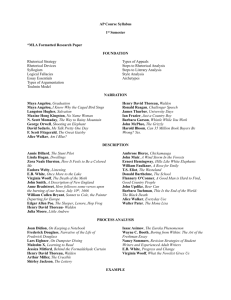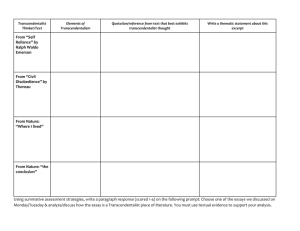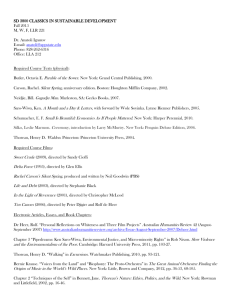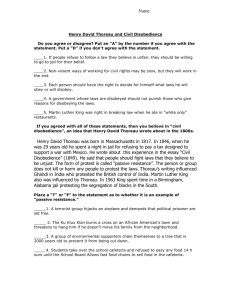Chapter 11 - Effingham County Schools
advertisement
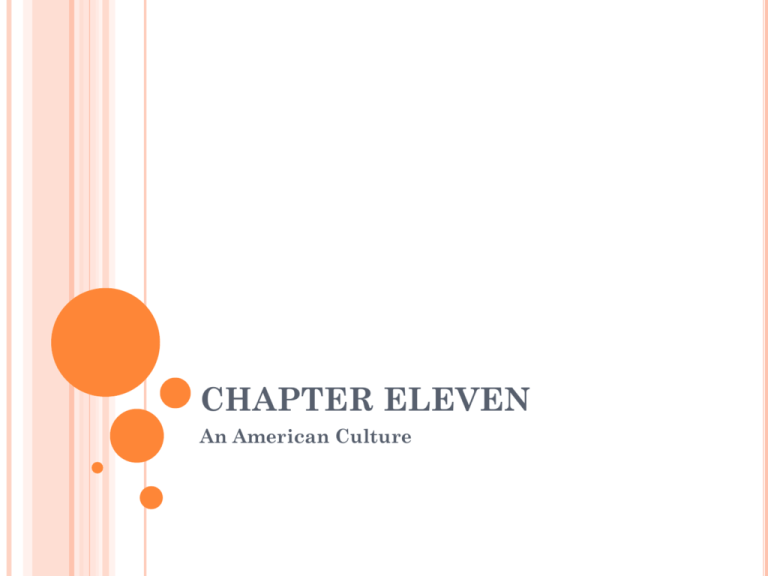
CHAPTER ELEVEN An American Culture AN AMERICAN CULTURE By the 1830s, the United States was developing its own distinct culture as illustrated by movements in literature, the arts, and education. Frederic Edwin Church conveyed the romantic sensibility in Twilight in the Wilderness (1860). The clouds glow with religious portent, and their reflected light pervades Nature. JAMES FENIMORE COOPER In Search of Native Grounds Of American novelists before 1830, only James Fenimore Cooper made successful use of the national heritage James Fenimore Cooper was the first American novelist to explore native themes, settings, and characters. The Spy (1821), The Pioneers (1823), The Last of the Mohicans (1826) AMERICAN PAINTERS American painting reached a level comparable to that of Europe, where many of the best American painters still trained American painters such as Benjamin West, John Singleton Copley, Charles Willson Peale, and Gilbert Stuart excelled as portraitists American painting was less obviously imitative of European styles than was American literature JOHN SINGLETON COPLEY Paul Revere by John Singleton Copley John Hancock by John Singleton Copley WASHINGTON CROSSING THE DELAWARE BY JOHN SINGLETON COPLEY BEN FRANKLIN BY BENJAMIN WEST THOMAS JEFFERSON BY CHARLES WILLSON PEALE GEORGE WASHINGTON BY GILBERT STUART ROMANTICISMTRANSCENDENTALISM The Romantic View of Life Romantic Movement—was a reaction against Age of Reason romantics valued emotion and intuition over pure reason, and they stressed individualism, optimism, patriotism, and ingeniousness Transcendentalism—a mystical, intuitive way of looking at life that aspired to go beyond the world of the senses, represented the fullest expression of romanticism LEADING TRANSCENDENTALIST THINKERS Ralph Waldo Emerson— THE leading transcendentalist thinker, urged Americans to put aside their devotion to things European and seek inspiration in immediate surroundings although he favored change and believed in progress, the new industrial society of New England disturbed him profoundly Emerson valued self-reliance and disliked powerful governments LEADING TRANSCENDENTALIST THINKERS Henry David Thoreau— like Emerson, Henry David Thoreau objected to society’s restrictions on the individual Thoreau spent two years living alone in a cabin at Walden Pond to prove that an individual need not depend on society, wrote Walden—antimaterialism Essay-“Civil Disobedience” explained view on proper relation b/t individual/state HENRY DAVID THOREAU, CIVIL DISOBEDIENCE WALDEN POND, AS SEEN TODAY, WHERE HENRY DAVID THOREAU LIVED FROM 1845 TO 1847: “I WENT TO THE WOODS BECAUSE I WISHED TO LIVE DELIBERATELY, TO FRONT ONLY THE ESSENTIAL FACTS OF LIFE, AND SEE IF I COULD NOT LEARN WHAT IT HAD TO TEACH, AND NOT, WHEN I CAME TO DIE, TO DISCOVER THAT I HAD NOT LIVED.” http://ricklondon.files.wordpress.com/2009/11/wal den3.jpg Transcendentalist Intellectuals/Writers Concord, MA Ralph Waldo Emerson Nature (1832) Self-Reliance (1841) Henry David Thoreau Walden (1854) Resistance to Civil Disobedience (1849) “The American Scholar” (1837) R3-1/3/4/5 EDGAR ALLAN POE Poe epitomized the romantic image of the tortured genius haunted by alcohol, melancholia, hallucinations, and debt, he was nevertheless a master short story writer and poet, a penetrating critic, and an excellent magazine editor ‘The Murder of Rue”, “Pit and Pendulum”, poem “The Raven” In 1845 Edgar Allan Poe, impoverished and an alcoholic, was living in the “greatest wretchedness.” His young wife was dying of tuberculosis. That same year he wrote “The Raven,” a poem about an ill-omened bird that intrudes on a young man’s grief over the death of his beloved. “Take thy beak from out of my heart” the man screams. Quoth the raven—famously—“Nevermore.” NATHANIEL HAWTHORNE Hawthorne rejected the egoism and optimism of transcendentalism he was fascinated by New England’s Puritan past and its continuing influence his best known works, including The Scarlet Letter and The House of the Seven Gables, concerned individuals and their struggle with sin, guilt, and the pride and isolation that often afflict those who place too much reliance on their own judgment HERMAN MELVILLE like Hawthorne, Melville could not accept the transcendentalists’ optimism he considered their vague talk about striving and their faith in the goodness of humanity complacent nonsense in his most famous work, Moby Dick, Melville dealt powerfully with the problems of good and evil, courage and cowardice, faith, stubbornness, and pride WALT WHITMAN the most romantic and distinctively American writer of his age, Whitman believed that a poet could best express himself by relying uncritically on his natural inclinations his greatest work, Leaves of Grass, often shocked or confused his readers with its commonplace subject matter and its coarse language WALT WHITMAN, THE MOST ROMANTIC AND THE MOST DISTINCTLY AMERICAN WRITER OF HIS AGE. (THE NATIONAL ARCHIVES) What was Whitman's greatest contribution to U.S. literature? Who were the other great writers of his age? What were the general themes of U.S. writing? THE WIDER LITERARY RENAISSANCE pre-Civil War literary renaissance also included New Englanders Henry Wadsworth Longfellow, John Greenleaf Whittier, Oliver Wendell Holmes, and James Russell Lowell Southern literature was even more markedly romantic than that of New England, as demonstrated by novelists John Pendleton Kennedy and William Gilmore Simms several historians achieved prominence during this period, including George Bancroft and Francis Parkman Henry Wadsworth Longfellow DOMESTIC TASTES Charles Bulfinch’s “Federal” style of architecture flourished in the North wood-turning machinery contributed to the popularity of the “Gothic” style “Greek” and “Italian” styles also flourished, the former particularly in the South new technology allowed the mass production of textiles with complicated designs, including wallpaper, rugs, and hangings DOMESTIC TASTES (CONT…) combined with the use of machine methods in the production of furniture, new textiles had a profound impact on furniture in American homes more affluent Americans decorated their homes with the works of American genre painters, “luminists,” and members of the Hudson River School beginning in the 1850s, the lithographs of Currier and Ives brought a fairly crude but charming form of art to a still wider audience EDUCATION FOR DEMOCRACY common school movement, led by Henry Barnard and Horace Mann, urged creation of stateadministered schools taught by professional teachers movement was based on an unquenchable faith in the improvability of the human race through education and a belief that democracy required an educated citizenry by the 1850s, every state outside the South provided free elementary schools and supported institutions to train teachers Horace Mann EDUCATION FOR DEMOCRACY (CONT…) historians have identified several reasons for the success of the common school movement common schools helped to “Americanize” immigrant children, and they brought Americans of different economic circumstances and ethnic backgrounds into early and mutually beneficial contact with one another they also instilled good employee values READING AND THE DISSEMINATION OF CULTURE as the population grew and became more concentrated, and as middle class values permeated American society, particularly in the North, popular concern for “culture” increased industrialization made it possible to satisfy this new demand improved printing techniques reduced the cost of books, magazines, and newspapers moralistic and sentimental “domestic” novels reached their peak of popularity in the 1850s READING AND THE DISSEMINATION OF CULTURE (CONT…) Americans devoured reams of religious literature self-improvement books were popular as well philanthropists established libraries and public lectures mutual improvement societies known as lyceums founded libraries, sponsored lectures, and lobbied for better education THE STATE OF THE COLLEGES the cost of private colleges meant that relatively few students could afford them; since students were hard to come by, discipline and academic standards were lax the college curriculum focused on the classics rather than on practical or scientific studies until the 1840s Harvard and Yale established schools of science; Harvard allowed students to choose some of their courses, and instituted grades THE STATE OF THE COLLEGES (CONT…) colleges in the South and West began to offer mechanical and agricultural subjects Oberlin College admitted women in 1837, and the Georgia Female College opened in 1839 white males constituted the overwhelming majority of students, but only 2 percent of white males went to college CIVIC CULTURES cities and towns sought to become local and regional centers of learning, art, and culture in the East, Boston, New York, and Philadelphia vied for primacy in the West, Cincinnati, Lexington, and Pittsburgh sought to become regional centers of culture members of the professions were generally accepted as the arbiters of taste in cultural matters SCIENTIFIC STIRRINGS few Americans pursued science on more than a part-time basis, and few American scientists achieved international recognition in the half century after the Revolution Tocqueville attributed this to Americans’ distrust of theory and abstract knowledge nevertheless, Americans accounted for some advances; national and state governments sponsored geological and coastal surveys; and the Smithsonian Institution was founded AMERICAN HUMOR the juxtaposition of high ideals and low reality formed the basis for much American humor James Russell Lowell’s Bigelow Papers turned “Down East” humor to more telling satirical effect Seba Smith’s character, Major Jack Downing, and Johnson J. Hooper’s creation, Simon Suggs, provided satirical lenses through which to examine Jacksonian America
